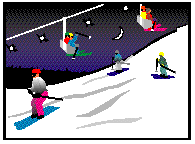

The ninth grade ARISE students have been asked the question " What are we going to do with our garbage when they close Mallard Lake Landfill and what will we do with the land on the closed landfill?" A student quickly asks "What is a landfill?" whereupon a field trip to the landfill is taken.
At the landfill, many questions are asked by the students about such things as "How much garbage comes in here each day?", "Where is this gas coming from that they are burning?", "What types of things can and cannot go into a landfill??, "How high is this hill?", and "Is this garbage polluting our air or water supplies?". The teacher suggests that everyone write down what questions they have in their journals and what things they think they need to know to solve the landfill problem.
The next day, the students discuss as a class the questions that they have, categorize them, and divide themselves into groups ( based on their interests) to start finding the answers to these questions.
During the course of their investigation, students are found using the internet to learn about the history and environmental impact of landfills, researching the local newspaper the DAILY HERALD for background information on Mallard Lake Landfill, sending e-mail messages to the DuPage Forest Preserve for specific information on the technological aspects of the landfill as well as their plans for its future.
The science department has a computer lab with 12 internet stations and students are free to go down to the lab during the day or use the 4 connections in the classroom. Students also have access to numerous CD-Roms and reference materials. When students ask questions that the teacher cannot answer, they are encouraged to seek out experts.

Over the next two weeks the various groups of 3-4 work on gathering information, performing experiments, writing in their journals and collaborating with each other. One group is collecting water samples and testing them for contamination such as phosphates, heavy metals, nitrates. Another group is researching the energy produced at the landfill and calculating the amount of energy produced per day and whether it is feasible to harness this energy for a useful purpose. A third group is visiting the landfill and using geometry to measure the height of the hill and the angle of the slope to determine whether it would be possible to use it as a ski hill in the future. Yet another group is investigating the types of chemical reactions and decomposition occurring in the landfill.

Two other groups are collaborating on their investigations of alternatives to traditional landfills and possible locations for our garbage when Mallard Lake closes. The aspiring lawyers in the class are researching the politics involved in the decisions made about the landfill and are interviewing County Board members and the landfill managers. They are conducting a survey among members of the community about their opinions on what should be done with the landfill and our garbage.
As information is collected and posted around the room on large poster sized sheets of paper, students are overheard expressing their amazement about the quantity of garbage that is collected everyday. They are beginning to understand the immense size of the problem of dealing with our garbage and the tremendous impact it has on the environment and the people living near it. Some of those students who live near the landfill are getting concerned about the effect it may be having on their own water supply and air quality.
The students are now beginning to collate their information in preparation for their final report and presentation. They have requested an audience with the County Board at their next public meeting to present their findings and recommendations and are writing the report to be published on the school server for the Web.

During the course of the project students have been responsible for daily journal entries which are checked weekly by the teacher. The teacher has been circulating around the room, checking on the progress of the students and making notes on the amount of participation from each student. When students are having difficulties with their progress, the teacher suggests new avenues to explore or a different direction to take.
Each group has turned in a written synopsis of their findings and presented it orally to the class in preparation for presentation to the Board. As a class, several days are devoted to making decisions about what exactly they want to say to the Board and what their recommendations will be. Students volunteer to complete the various tasks involved with completing the final report and students are selected by consensus to make the oral presentation to the Board. Excitement builds as the day for the presentation approaches.
The evening of the Board meeting the Board President welcomes the students and limits them to a 15 minute time period to make their presentation. The students nervously set up their charts and pass out copies of their report to the Board. After the presentation the Board expresses that they are impressed with the quality of the research the students have done and appreciate their time and concern. They promise to consider the students' recommendations and will let the students know about their decisions on the landfill in the future.
The next day in class the classroom is abuzz with discussions on how the presentation went and whether the Board was really receptive to their suggestions. The students are then asked to fill out a self evaluation, peer evaluation, group evaluation and an overall project evaluation.
Students will be assessed according to the following generalized rubric:

Total Point Value: 100 points
Science Content
Persuasive Discourse
Originality/ Creativity
Use of Technology
Contributions
Time use
Leadership
Students are asked to create the specific rubric based on the above guidelines.